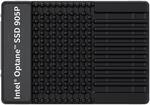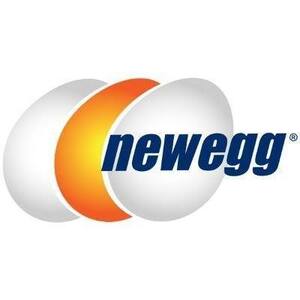Intereresting drive, if you need one this is pretty cheap for a large storage pool!
Intel Optane 905P Series 1.5TB 2.5" X 15mm, U.2, PCIe 3.0 X4, 3D Xpoint Solid State Drive (SSD) A$612.52 Delivered @ Newegg
Related Stores
closed Comments

2tb nvme gen4 should be around $150 each?
the 4 slot cards are under $50
gives you 8tb… not sure why you would want this at home
saying that i have a 4 nvme card in my other pc but only with 2 x 1tb

Not my point, my point is this item is useless.
You'd buy what you needed… I meant for THAT price you could get a 4 port with like 4x 2TB even
You'd likely actually just need https://www.amazon.com.au/UGREEN-NVMe-Adapter-M-Key-B-Key/dp…

You don't know what an Optane drives usecase is. The fact that you're even comparing it to NVMe tells me you are not informed.

@jasonxc: Enlighten me..?
Google doesn’t show much beyond it’s an SSD with RAM caching, quite common these days.
Intel outage h10 has an endurance rating of 150 TBW or 0.15PB there shouts.
So it’s a lot more cycles, I see that. Is someone on ozbargain looking to build an enterprise dedicated server to resell VPSs or something? If that’s the use case there’s alternatives to…
Edit: I note dell does overcharge for these (there version is $1,800), but that’s common for new server hardware. You can choose other options.
If you’re that big into compensating for something, micron 9550 may be an alternative? Its rating is 1 DWPD, at 3.84TB that gives us 7PB of my math is correct (5 years warranty), over half that to closer to similar to this drives size and it’s PB
Alternatively a Samsung PM1743, a bit lower specced and actually available already as a standalone (not as a full server solution). About $1000 for 3.84TB - similar per GB to this.
tl;dr what’s your use case? There’s better options, either a standard NVMe or an actual data centre drive. Not some outdated 4.0 in between. These really aren’t for consumer use, they’re high end data centre drives usually utilised with AI systems, though sometimes with high end storage and VPS solutions
Sarcastic note, here’s a server to go with your drive…
https://www.lenovo.com/au/en/p/servers-storage/servers/missi…
You just may need up to 16 of them to make full use of it!

@Dyl: Yeah this is one of those situations where if you don't know what you need, then you don't need this.
Primary advantages of Optane are extremely low latency and high endurance (for non-volatile storage). It can be used as bigger, cheaper, slower RAM; like in AI or scientific computing.
And yes, some people are wanting to do this on their home computer.
Note: Buying a server is exactly the opposite use case for this drive. A server is capable of fitting 1.5TB RAM and they are priced in a different league.

@grb: There are many problems with Optane, the main one is still the crazy price.
- U2 interface, for most people, that means a converter card is required.
- 905P is old and PCIe gen 3 x4 only.
- Mainstream 2TB NVMe SSDs such as SN570 and SN580 has a pSLC cache close to 900GB.
- Optane helps AI heaps makes no sense, you are better off using that money towards a better GPU.
- 4K random read advantage. Let's face it, most of us don't open Photoshop + Illustrator + Premiere + Office Apps + 3D rendering applications all at the same time.
- Optane as a RAM replacement doesn't make sense either. If it does, then we can all go out and buy a cheap $9 Optane 16GB. There is no chance that is good enough to replace 16GB of RAM (the latency is still way off).
PCIe gen 4 x4 class Optane products have even more ridiculous prices.

@netsurfer: The price, no future development, and higher power consumption (not a lot but enough to not put them in laptops) are pretty much it.
The samsung and micron ssds listed above are some of the fastest you can get and cost more. They also have lower endurance (x10 or more) and 4k write iops, 250,000/s and 280,000/s respectively, vs 500,000/s for the 5 year old 905p and 1.6million/s for the 3 year old P5800x.
If intel went ahead and developed a new PCIE 5 optane drive today you could expect double that again.
There's a reason optane is still expensive. It's because it's better than flash. If it was as cheap as flash then we'd all switch and never look back.

@netsurfer: The advantages I mentioned are for datasets (AI and scientific computing) which can use many hundreds of gigabytes or terabytes of storage, and can require consistant random access. Though there are plenty of other situations where Optane also pwns.
Not all applications. Not all AI or scientific applications. But there is a legitimate niche to which this reasoning applies.
Optane drives provide a balance between affordability, size, endurance, and latency which nothing can compete with.
Suggesting a "better GPU" could be a solution to this problem shows you truly don't understand the requirements of this niche, and I suggest you simply listen to the advice of people who are more informed.

905P is old and PCIe gen 3 x4 only.
Not a valid argument.
Old Optane drives with 3D XPoint absolutely destroy PCIe 5.0 drives in random r/w, which is exactly what their usecase is designed for.Let's face it, most of us don't open Photoshop + Illustrator + Premiere + Office Apps + 3D rendering applications all at the same time.
Clearly you don't have any understanding of what Optane is designed for. You don't even understand what kind of software benefits from 4K/QD1 reads.

@jasonxc: I have multiple Optane devices and I am just not impressed by the PCIe gen 3 x4 ones.
Why don't you list some of the software that can benefit from 4K/QD1 reads? Wendell / Level1 showed Optane's noticeable advantage when you open multiple bigger apps concurrently.
The main issues with older and low end Optane are: 4K/QD1 reads isn't something most people care that much. How many of us reboot our PCs/laptops every day? A lot of us have ample RAM on our PCs. The sequential write, with SSDs doing SLC cache cheating is just too large for PCIe gen 3x4 Optane to matter.
Old Optane drives with 3D XPoint absolutely destroy PCIe 5.0 drives in random r/w
That's not true. At QD1 random read, yes. At high queue depth, no (and that's why it's hard to impress general public). I am not happy with my Optane's high queue depth random read/write got beaten by PCIe gen 4 x4 SSDs. Low end Optane devices are even more annoying:
Hybrid Optane + QLC SSD setup is a real pain. You need to find an older Intel PC to run it properly. On AMD systems, you ended up getting a PCIe gen 3 x2 QLC SSD without Optane at all. As for the cheap Optane cache 16GB, why don't you tell me how to use it to impress? It is once again PCIe gen 3 x2 and it's too small to be useful. Even when I put some apps on that, I am not impressed at all.

@netsurfer: Want to use a 16gb optane nvme to impress? Put it in front of a raid 5 ssd based database and benchmark the small write tps…

Endurance Rating (Lifetime) 27.37 PB Written
https://www.intel.com/content/www/us/en/products/sku/147526/…
holy guacamole

This - the only reason to buy Optane drive now is either for its absurd DWPD or tones of 4K IOPS.

it’ uses xpoint cells, so extremely durable, more than about octane as a cache, the octane cache market went dry once nvme went mainstream vs sata.

good deal!

I've been following the STH deals forums for a while now, and although this model pops up on sale regularly it's always in the context of someone from the US posting a new region-locked Newegg coupon that wont work for Australians. For us I think the price has generally been about 600-650 AUD which with Newegg's "free delivery" to Aus isn't necessarily a bad deal if you want/need a 1.5TB Optane drive plus warranty, but it's frustrating knowing if we were actually allowed to access those deals the price would go down to ~500 AUD (or ~$430 after subtracting the 50 USD redeemable rebate they got as part of the last promo I saw).

STH?

Servethehome

the selling point is that it’s xpoint cells, through the roof durability compared to other tech for write intensive purposes,

Didn’t Intel abandoned the whole Optane business? If so this drive will be an orphan wherever you use it.

Yes Optane is dead afaik. The drive is still good and warranty should be OK as long as they have stockpiled enough replacement drives for RMAs

intel and micron developed xpoint which optane uses, they seem to be moving away from xpoint cells possibly due to cost to manufacture and limited demand for the premium it costs for speed and durability.


Cheaper to just buy an NVMe adaptor and put up to 4 drives in it?